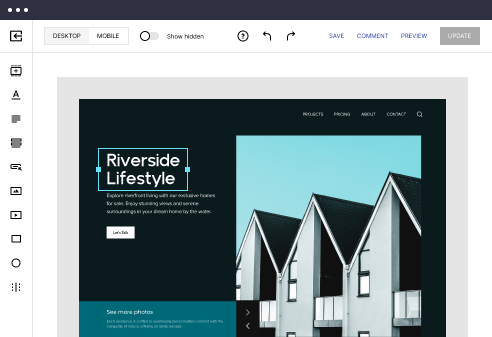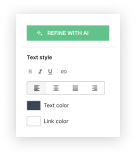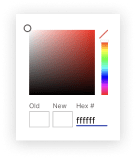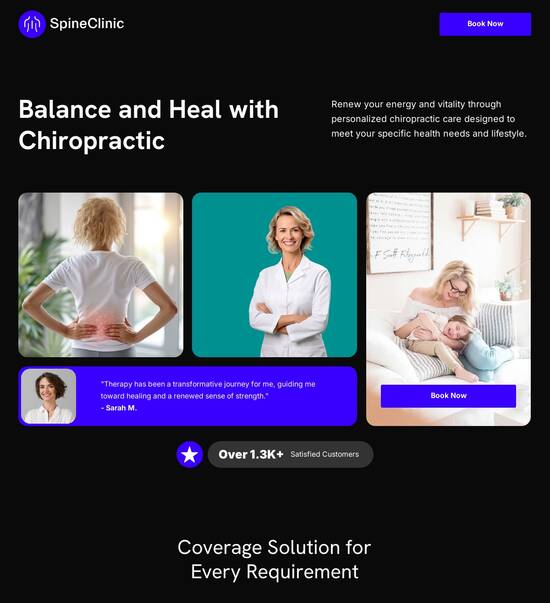
Angular.js optimized chatbot page template
Explore Similar TemplatesAbout template
Supercharge your chatbot page with Angular.js for outstanding performance! Learn more today.
Recommended templates
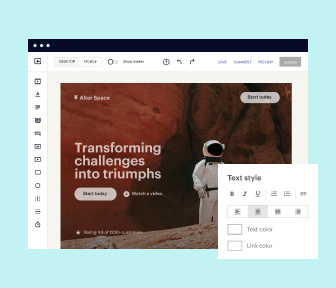
Easy to build without coding
With the intuitive drag-and-drop builder, anyone on your team can create high-converting pages without any knowledge of code or design. Make enhancements to your landing page with custom widgets using Javascript, HTML/CSS, or third-party scripts.
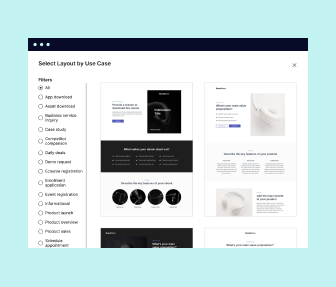
Multiple layouts for any industry and goal
Select from 500+ landing page layouts built to boost conversions across industry-specific scenarios. Customize them by adjusting fonts, adding images, and generating on-brand content with the AI assistant. Quickly scale with Instablocks® and Global Blocks that you can save, reuse, and update globally.
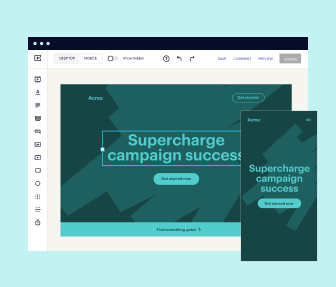
Loads fast and looks polished on any device
Every template is responsive, which means they present professionally on any device and load blazingly fast with our Thor Render Engine. You can also power them up with Google AMP technology to deliver an unparalleled mobile experience and drive higher conversions.
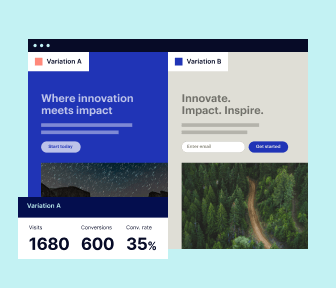
Robust analytics & experimentation
Get real-time updates and reporting across all your devices, showing the number of visitors, conversions, cost-per-visitor, and cost-per-lead. Launch AI-powered experiments, run A/B tests, and use heatmaps to analyze user behavior, then optimize your landing page to maximize conversions.

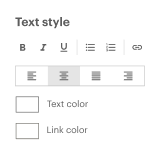
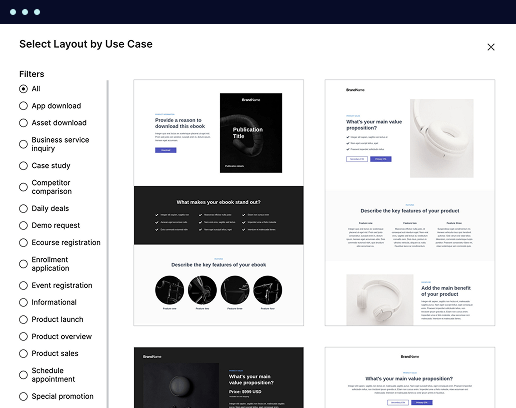
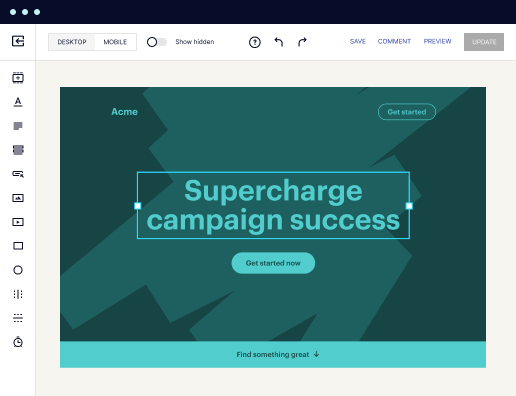
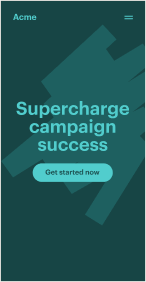
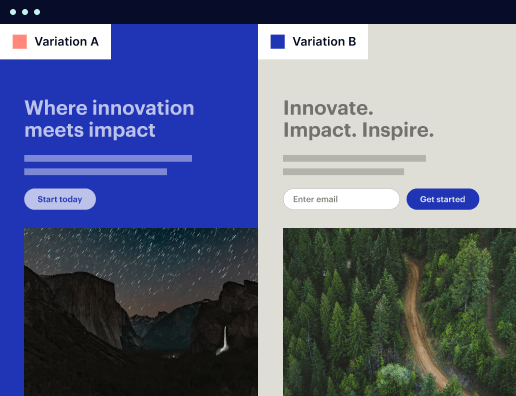

Easy to build without coding
With the intuitive drag-and-drop builder, anyone on your team can create high-converting pages without any knowledge of code or design. Make enhancements to your landing page with custom widgets using Javascript, HTML/CSS, or third-party scripts.
Multiple layouts for any industry and goal
Select from 500+ landing page layouts built to boost conversions across industry-specific scenarios. Customize them by adjusting fonts, adding images, and generating on-brand content with the AI assistant. Quickly scale with Instablocks® and Global Blocks that you can save, reuse, and update globally.
Loads fast and looks polished on any device
Every template is responsive, which means they present professionally on any device and load blazingly fast with our Thor Render Engine.
Robust analytics & experimentation
Get real-time updates and reporting across all your devices, showing the number of visitors, conversions, cost-per-visitor, and cost-per-lead. Launch AI-powered experiments, run A/B tests, and use heatmaps to analyze user behavior, then optimize your landing page to maximize conversions.
All the features you need to build angular chatbot ui template
Explore more featuresLearn how to build angular chatbot ui
Frequently asked questions about angular material chat template
Leading the way in building high-performing landing pages





Angular chatbot ui template free: Your ultimate how-to guide
Instapage's landing page and CRO platform is designed for marketers aiming to enhance their digital marketing efforts. With a suite of tools to accelerate, optimize, scale, and maximize ROI, marketers in sectors like business services, tech, education, and finance can achieve exceptional results. This guide will walk you through the essential steps to leverage Instapage effectively.
Getting Started with Instapage
To begin using Instapage, explore its intuitive UI and familiar layout. Navigate through the various options to find over 100 high-converting templates ready to be customized according to your needs. The ease of adding lead generation elements helps you capture crucial data swiftly.
- Explore the template library: Choose from 100+ pre-built landing pages catered to your audience.
- Use the drag-and-drop builder: Quickly customize templates without needing coding skills.
- Integrate lead generation forms: Enhance the chances of capturing leads directly through your landing pages.
Optimizing Your Landing Pages
Optimization is at the heart of increasing conversion rates. Utilize Instapage's built-in experimentation tools to refine your landing pages effectively.
- Analyze user behavior with heatmaps: Gain insights into how users interact with your page to make data-driven decisions.
- Implement A/B testing: Experiment with different headlines and layouts to see which performs better.
- Utilize analytics dashboards: Monitor performance metrics to continually tweak your strategies.
Personalization for Tailored Experiences
Personalized content can lead to higher engagement rates. Instapage allows for dynamic text replacement and audience segmentation.
- Dynamic text replacement: Automatically adjust the content based on user preferences or previous interactions.
- AdMaps configuration: Align specific ad campaigns to the most relevant landing pages.
- Audience tracking: Utilize data tools to measure the effectiveness of personalized approaches in real-time.
Collaborative Workflow
Enhancing productivity through collaboration features can significantly reduce the time taken from creation to launch. Feedback loops enable real-time improvements.
- Real-time page editing: Work with team members simultaneously to refine ideas quickly.
- Instant feedback tools: Share ideas with stakeholders quickly and receive immediate input.
- Securely share with external parties: Enable client reviews without compromising security.
By following these steps, you're well on your way to creating impactful landing pages that maximize your marketing campaigns' ROI.
Ready to accelerate your marketing efforts? Sign up for Instapage today and start transforming your digital campaigns!
AngularJS optimized chatbot page template
Understanding chatbots: The backbone of user interaction
Chatbots are becoming essential components for enhancing user interaction across various web platforms. A chatbot is essentially a software application that simulates human conversation, allowing users to engage in dialogue for various purposes. Initially, chatbots emerged to provide basic question-and-answer functions; however, as technology has progressed, their role has expanded significantly. Today's chatbots encompass AI features, enabling more sophisticated and contextual conversations, thus meeting more complex user needs.
With the evolution of chatbots integrated into web applications, they have transformed from simple text parsers into dynamic conversational agents that improve user experiences. They serve not just as operational tools but as instruments that foster a connection between users and brands. Whether it’s answering inquiries, guiding users through processes, or gathering feedback, chatbots fulfill a critical function in modern web interactions.
How chatbots enhance user experience
One of the significant advantages of chatbots is their ability to deliver instant responses to user queries. Instantaneous engagement eliminates waiting time, creating an efficient user experience and allowing users to gather information at their convenience. Additionally, chatbots are available around the clock, providing consistent support even outside traditional business hours. This 24/7 availability aligns with the increasing user demand for instant support-driven solutions.
Moreover, chatbots can deliver personalized experiences by analyzing user data and behavior. This personalization not only drives engagement but fosters a connection that enhances brand loyalty. As users feel more recognized and valued, they are likely to return, reinforcing the chatbot's role as a crucial tool in customer relationship management.
AngularJS: The framework for modern web applications
AngularJS stands at the forefront of modern web application development. This JavaScript framework is renowned for its versatile set of features, including two-way data binding, dependency injection, and templating capabilities. The use of AngularJS promotes a well-organized and structured approach to developing web applications, particularly beneficial for building complex interfaces like chatbots.
Unlike other JavaScript frameworks, AngularJS employs a model-view-controller (MVC) architecture, allowing for seamless data flow and separation of concerns in application structure. By utilizing this architecture, developers can manage complex user interfaces efficiently while ensuring an optimum user experience. With its built-in testing framework, AngularJS also supports the creation of robust applications, ensuring that code remains error-free through rigorous testing.
Why choose AngularJS for chatbot development?
A standout feature of AngularJS is its two-way data binding, which allows real-time synchronization between the model and the view. This functionality comes into play significantly when developing chatbots, where user inputs and system responses need to update dynamically without refreshing the page. Such a capability greatly enhances the interaction fluidity and offers a more engaging user experience.
Given these advantages, AngularJS proves to be an ideal choice for developing chatbots. Its architecture allows developers to create highly maintainable applications that can scale seamlessly as user requirements evolve.
Building an optimized chatbot page template with AngularJS
Creating an effective chatbot page template using AngularJS involves several critical components. The user interface is one of the foundational elements of this template. Essential components include input fields for user queries, buttons for sending messages, and a chat history panel displaying the conversation dynamically. An intuitive and visually appealing interface enhances user engagement.
Moreover, backend service integration is crucial for the chatbot to function correctly. To build a robust solution, developers should incorporate RESTful APIs that allow the chatbot to communicate with external services, providing real-time data access to users. Utilizing such services improves the chatbot's capabilities significantly, creating a more fulfilling user experience.
Controllers: The core logic of your chatbot
Within AngularJS, the controller serves as a pivotal layer managing the application logic. For chatbot functionality, the controller helps in handling user inputs and managing how responses are generated. AngularJS controllers can take incoming data, process it, and communicate back to the user, forming the heart of chatbot interactions.
Additionally, script management is essential for maintaining organized code and ensuring seamless interactions. By structuring scripts effectively, developers can enhance the chatbot’s ability to handle diverse types of user inputs while maintaining coherent conversations.
Template development: Structuring your chatbot experience
The template developed for an AngularJS chatbot should focus on creating responsive layouts that adapt to various devices. Keeping users in mind, it’s vital to optimize content for clarity and accessibility. Considerations should include font size, button placement, and color contrast to ensure that users can navigate the chatbot easily, regardless of their device or environment.
Furthermore, using AngularJS's template capabilities, developers can produce reusable components that maintain consistency across the chatbot experience. This level of structure not only improves user satisfaction but also allows for efficient management of updates and changes.
Technologies that power AngularJS chatbots
Integrating external APIs is fundamental to enhancing the capabilities of AngularJS chatbots. Leveraging third-party APIs enables the chatbot to access vast knowledge bases and information. Not only do APIs improve the chatbot's functionality, but they also allow for dynamic updates, thus keeping the interactions relevant and contextually aware.
Incorporating machine learning and AI technologies further expands the potential of chatbots. By training machines to understand user intent and context, chatbots can provide more meaningful and coherent responses, leading to improved user interactions. Basic concepts of AI integration may include natural language processing (NLP) for understanding user language and sentiment analysis to gauge user emotions.
Leveraging machine learning and AI
Moreover, as AI technology evolves, chatbots become increasingly adept at managing complex conversation flows. Training models allow chatbots to learn from past interactions, adjusting their responses based on user behavior and preferences. This ongoing learning process makes it possible to create sophisticated conversation that evolves as user needs change, thus improving user satisfaction continually.
Designing the user interaction flow
For an optimized chatbot interaction, it's essential to map out anticipated user questions and develop tailored responses. By foreseeing common queries, developers can streamline the chatbot's interaction flows. This proactive approach ensures that users receive quick, relevant answers, thus enhancing the overall experience.
Additionally, creating a robust knowledge base is vital for effective Q&A functionality. Structure this content for easy retrieval to ensure that users receive accurate answers swiftly. By utilizing community input to crowdsource knowledge, businesses can continuously enhance their knowledge base, improving chatbot effectiveness over time.
Testing and optimization strategies
Usability testing is a fundamental aspect of refining the chatbot experience. By employing A/B testing, developers can analyze different dialog flows and responses, gathering valuable user feedback to inform adjustments. This iterative process helps ensure that the chatbot addresses user needs effectively, enhancing the overall user experience.
In parallel, performance optimization techniques are essential for delivering rapid loading times and responsive interactions. Developers should monitor application performance regularly and ensure that resources are utilized efficiently, accommodating potential increases in user volume seamlessly.
Community and support: Fostering a collective learning environment
Engaging with developer communities serves as a valuable resource for learning and growing as an AngularJS developer. Platforms like Stack Overflow, GitHub, and community forums provide opportunities to share insights and best practices, enabling developers to stay updated with the latest trends and solutions in chatbot development.
Furthermore, access to learning resources, workshops, and webinars plays a crucial role in continuous education. It is increasingly important for developers to cultivate their skills, and these resources help reinforce knowledge and adapt to the rapidly changing technology landscape.
Case studies: Successful implementations of AngularJS chatbots
Analyzing real-world use cases of AngularJS chatbots can provide significant insights into their versatility and effectiveness across various industries. For instance, in the e-commerce sector, chatbots streamlining customer support have been able to drastically reduce response times, enhance user satisfaction, and improve sales conversion rates.
Additionally, user testimonials can highlight how chatbots have transformed interactions and business operations. Many organizations have reported increased engagement metrics and improved customer satisfaction scores since implementing AI-driven chatbots in their operations.
Future directions: Trends in chatbot technology
As technology evolves, the expectations for chatbots also transform. Predictive analytics, for instance, is paving the way for the next generation of chatbots that proactively engage users based on gathered data and previous interactions. This shift towards more engaging and intuitive interactions is crucial for retaining user interest and driving conversions.
Moreover, as the digital landscape shifts, chatbots will play a leading role in the digital transformation of businesses. With more organizations leveraging this technology, remaining competitive means adopting advanced chatbot functionalities that provide scalable, efficient solutions.
Location and accessibility: Global reach of chatbots
As businesses expand their reach, chatbots are positioned to accommodate diverse user bases with multilingual capabilities. Incorporating language models enables chatbots to support users from different linguistic backgrounds, promoting inclusivity and accessibility in web interactions.
Additionally, designing chatbots for different user environments ensures that services meet various usability standards. Whether users are interacting via mobile devices, desktop applications, or other platforms, the overall experience must remain consistent, accessible, and effective.
Ready to skyrocket conversions?
Supercharge your ad campaigns with high-performing landing pages
Get started